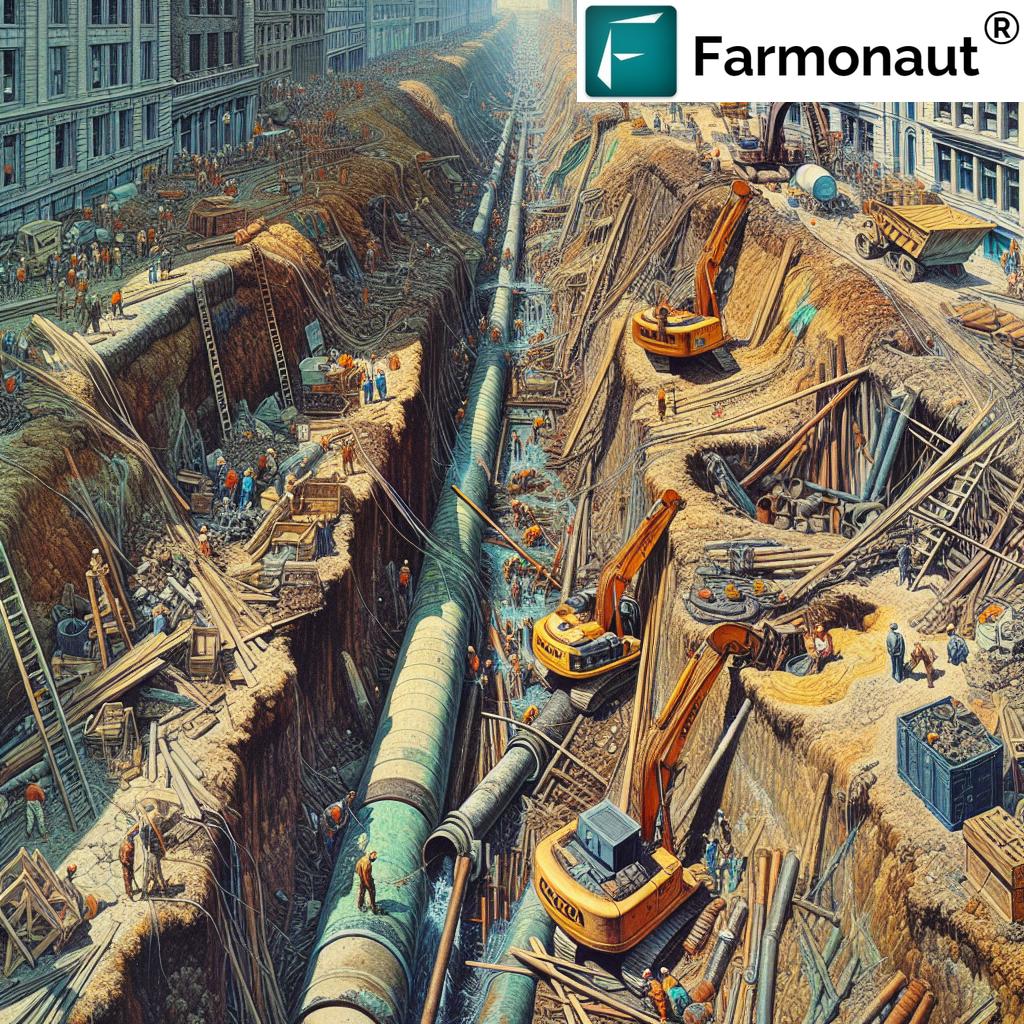Summit Street Fairhope Repairs: Urgent Drainage Failure Update 2025
Table of Contents
- Summary of the Summit Street Fairhope Repairs
- Incident Context: Downtown Drainage System Failure
- Project Scope: Emergency Road Repairs & Drainage Restoration
- Emergency Road Closure Fairhope: Detours and Local Impact
- Project Timeline & Impact Table
- Failure Analysis: Corrugated Metal Pipe, Outfall, and Gulley Erosion
- City Council Infrastructure Plans & Budget Allocations
- Bon Secour Street Drainage Repairs: Parallel Projects & Costs
- How Smart Technologies like Farmonaut Support Modern Infrastructure
- Next Steps: Road to Recovery & Community Communication
- Frequently Asked Questions (FAQ)
- Conclusion
“Over 1,200 feet of Summit Street’s drainage system failed after record rainfall in early 2025, prompting emergency repairs.”
Summary of the Summit Street Fairhope Repairs
The Summit Street Fairhope repairs are at the forefront of municipal news in 2025, addressing severe downtown drainage system failure after heavy rain erosion. A significant road undermined by storm runoff led to an emergency road closure in Fairhope, disrupting local traffic and business, and prompting immediate action from city officials. We will detail the context, scope of damage, emergency repair plans, associated costs (nearly half a million dollars), challenges posed by corrugated metal pipe failure, and the city’s robust response to ensure public safety and infrastructure resilience. Read on for expert analysis—industry trends, project timelines, and how technology like Farmonaut can inform future municipal planning.
Incident Context: Downtown Drainage System Failure
When the city of Fairhope, Alabama, woke up on Saturday morning after heavy rains on May 9, 2025, a significant section of Summit Street was already closed, signaling trouble. Runoff from the overnight storm severely damaged the gulley adjacent to the road, with the substructure eroded after years of stress on an aging drainage system. Corroded, corrugated metal pipes—put in place more than 50 years ago—finally reached critical failure, accelerating erosion at the outfall and washing out an area already weakened by recent storms.
According to Fairhope City Engineer, Richard Johnson, the problem was not only urgent but “more than typical”. The outfall failure left a 40-foot drop to the bottom of Stack’s Gulley where the road was undermined, highlighting the need for a large-scale intervention. The drainage system here was previously identified as a problem spot and was scheduled for replacement in the city’s budget this year—yet Mother Nature forced a much faster timeline.
The city of Fairhope has stepped up, with council and engineering teams moving at speed to issue bids and begin restoration. The closure, while relatively minor in terms of daily traffic use, sits at the heart of downtown and impacts commerce and community.
For an emergency facing thousands of cities worldwide, the story of Summit Street’s drainage system failure is a cautionary tale of infrastructure neglect, aging systems, and the power of extreme weather.
Project Scope: Emergency Road Repairs & Drainage Restoration
Let us break down the comprehensive scope for the Summit Street Fairhope repairs and the critical next steps to restore both safety and functionality to the area.
- Replace the entire drainage system—from corrugated metal pipe failure points to the outfall at Stack’s Gulley—with modern, long-lasting concrete infrastructure.
- Backfill significant soil loss and restore the undermined roadway supporting Summit Street’s passage.
- Rework the adjacent gulley’s contours to stabilize slopes and prevent further erosion or sudden drops to the gulley bottom.
- Address similar failures at Bon Secour Street and Grand Avenue, another section with aging, corroded outflow pipes near the end of their lifespan.
- Implement a repair methodology designed for fifty to a hundred years of resiliency, incorporating lessons from recent disasters and advances in infrastructure engineering.
The estimated cost for the Summit Street project alone is around $200,000, with Bon Secour and Grand Avenue outflow restoration costing about a quarter million dollars. The combined price tag for Fairhope approaches half a million, signifying how urgent and massive this infrastructure challenge really is.
Developers or organizations interested in integrating satellite-data-based monitoring for remote locations, asset management, or infrastructure assessment can visit our API page. Access developer documentation here.
Emergency Road Closure Fairhope: Detours and Local Impact
As repairs begin, Summit Street will remain closed until emergency work is done. Fortunately, the affected section is not a main thoroughfare but is close enough to downtown Fairhope that detours need to be clearly marked and communicated.
- Complete road closure will persist during excavation, replacement, and backfill of the affected area—anticipated for at least one month.
- Public detour routes are being established, minimizing disruption for both local residents and downtown businesses.
- The Summit Street closure is only a couple blocks from the business district, yet remains a valuable access point for downtown commerce and services.
- Traffic management and safety barricades are reinforced, especially as the erosion has created a notable 40-foot drop at the gulley bottom.
“Summit Street’s emergency closure impacted access for more than 30 downtown businesses during the critical repair phase.”
Project Timeline & Impact Table
The following table summarizes the phases, durations, and impact of the Summit Street Fairhope repairs. These dates are preliminary estimates and subject to weather conditions, contractor mobilization, and findings during excavation.
Failure Analysis: Corrugated Metal Pipe, Outfall, and Gulley Erosion
Focus Keyword: Outfall Failure Repair Project
The roots of the downtown drainage system failure can be traced years ago when corrugated metal pipes—then a state-of-the-art solution—were installed to channel urban runoff into the natural gulley. Over decades, these pipes became corroded, especially at outflow points exposed to continuous water flow and chemical reaction with sediment. Severe storms only hastened their demise. Here’s a technical primer on the issues driving the Summit Street Fairhope repairs:
- Corroded Metal Pipe: Metal’s long-term exposure to water, salts, organics rapidly reduced durability—modern engineering prefers reinforced concrete for these use-cases.
- Outfall Undermining: When water is no longer diverted or slowed at the outfall, it aggressively erodes gulley banks and supporting soil, leading to rapid drop and collapse.
- Soil Loss and Roadway Undermining: Rainwater finds the path of least resistance, often exploiting hidden voids. The more water travels through these weak points, the more soil loss occurs.
Engineering teams are tasked with not only restoring the Summit Street and Stack’s Gulley interface but also providing a repair methodology that anticipates fifty to one hundred years of resiliency. This means deploying:
- High-strength, large-diameter concrete pipe for all new installations.
- Enhanced erosion-resistant outfalls with energy-dissipating features.
- Graded, engineered backfill and compacted sublayers to restore road surface integrity.
For urban planners and engineers, modern spatial monitoring tools can aid in preventing similar failures. Farmonaut’s large-scale monitoring app allows for remote tracking of environmental wear, enabling risk mapping and early warning.
City Council Infrastructure Plans & Budget Allocations
Fairhope City Council will address the Summit Street Fairhope repairs as a top priority in their next work session, expediting bids and mobilizing contractors without delay. The expedited timeline is a significant departure from the original plan, which placed this project later in the city’s 2025 budget cycle. Instead, Richard Johnson and the city engineering office are:
- Prioritizing emergency bids, with council sessions set to approve contractors by the end of the month. This circumvents normal municipal delays and accelerates stabilization work.
- Allocating emergency funds to address not just Summit Street but also the similar outflow failure at Bon Secour Street and Grand Avenue.
- Employing a repair methodology that addresses root causes, not just visible symptoms, by specifying higher-end materials and longer design lives in procurement documents.
The combined cost for these emergency projects is expected to reach half a million dollars, substantially more than the usual maintenance outlay. The city is betting this investment brings resilience for decades—and avoids much costlier disaster in the future.
Bon Secour Street Drainage Repairs: Parallel Projects & Costs
Focus Keyword: Bon Secour Street Drainage Repairs
The Bon Secour Street drainage repairs (at Grand Avenue) mirror the Summit Street Fairhope repairs in both root cause and solution methodology. Corroded corrugated metal pipe at the end of its lifespan exacerbates storm runoff problems, creating outflow instability and localized gulley erosion.
- Estimated cost: Quarter million dollars.
- Repair involves full corrugated metal pipe replacement, backfill, and slope stabilization.
- Same contractor pool as Summit Street project, optimizing resource and supply procurement.
Both projects are being monitored to ensure that scheduling does not overly disrupt local access. The outcome aims for 50–100 years of service, thus restoring community faith in the city’s infrastructure planning.
Businesses interested in guaranteeing product quality and transparency through traceable supply chains can leverage the Farmonaut blockchain-based traceability solution. This provides verifiable product journey data from farm to table.
How Smart Technologies like Farmonaut Support Modern Infrastructure
While the current Summit Street Fairhope repairs focus on urgent response, there are long-term lessons in risk mitigation and proactive management. New data-driven technologies—such as those pioneered by Farmonaut—offer unique benefits for urban planners, municipalities, and the wider agricultural and infrastructure landscape.
Farmonaut for Urban and Rural Asset Monitoring
- Satellite-Based Infrastructure Assessment: Farmonaut leverages multispectral satellite imagery to enable real-time, large-area monitoring of “problem spots,” enabling early detection of potential drainage, soil, and surface issues before catastrophic failure.
- AI & Predictive Analytics: The Jeevn AI advisory system delivers dynamic recommendations based on historical trends, weather, and structural data—highly applicable for large towns seeking to maintain asset longevity and resilience.
- Resource & Fleet Management: Municipalities responsible for large-scale repairs, contractor movements, or multi-phase projects may utilize Farmonaut’s fleet and resource management tools to efficiently dispatch, monitor, and optimize response during emergencies.
- Environmental Compliance and Carbon Tracking: Cities can reduce their environmental impact through tools like Farmonaut’s carbon footprinting, providing actionable metrics during infrastructure improvements.
- Funding Support for Infrastructure: Banks & insurers can verify repair claims and progress with Farmonaut’s crop loan and insurance verification services, reducing risk and ensuring compliance in publicly funded repairs.
Farmonaut delivers all these services through both mobile and web apps, putting precision data management within reach for city planners as well as agricultural stakeholders.
Next Steps: Road to Recovery & Community Communication
Looking forward, the Summit Street Fairhope repairs transition from emergency triage to long-term resilience. Key upcoming milestones include:
- Fast-tracking contractor selection and mobilization (within two weeks).
- Daily progress reports to residents and businesses, especially those most affected by access changes.
- On-site safety audits and environmental assessment at each project phase.
- Collaborative planning to concurrently launch drainage outflow repairs at Bon Secour St and Grand Ave, minimizing future disruptions.
Frequently Asked Questions (FAQ)
Why did the Summit Street drainage system fail so suddenly?
The drainage system’s failure was a result of decades-old corroded corrugated metal pipes finally reaching the end of their lifespan, further stressed by record heavy rain on May 9, 2025. This caused severe erosion and an outfall collapse, resulting in immediate loss of structural support beneath the street surface.
How long will Summit Street remain closed for repairs?
Current estimates suggest at least one month of full closure, with phased reopening after safety inspections and final road surface work.
Who is responsible for these emergency repairs?
The City of Fairhope (City Council and Engineering) is leading the emergency response, fast-tracking bids and contractor mobilization to ensure timely completion.
Are similar failures expected elsewhere in Fairhope?
Yes. Another high-risk spot is the outflow pipe at Bon Secour Street and Grand Avenue. Proactive replacement of other aging infrastructure is being planned to avoid future failures.
How will these repairs prevent future incidents?
The repairs specify reinforced concrete, up-to-date engineering standards, and a robust outfall design to ensure the new systems last 50–100 years and better resist erosion from both normal and extreme weather events.
How does the city ensure accountability and progress?
Transparent project timelines, third-party inspections, and regular public communications ensure accountability. Technologies like Farmonaut can support evidence-based monitoring for verification and reporting needs.
Conclusion: Building Resilience in the Face of Urgent Infrastructure Failures
The Summit Street Fairhope repairs underscore the importance of timely action, the consequences of aging urban infrastructure, and the demands placed on city governments to adapt quickly in the face of climate extremes. These repairs are about restoring a roadway—but also about restoring confidence in the city’s capacity to manage critical risk.
Fairhope’s investment in drainage system replacement, emergency erosion mitigation, and upgraded outfall designs is forward-looking, setting a benchmark for cities nationwide. For communities, business owners, and engineers, this episode is a call to embrace smart planning—combining traditional engineering with modern data tools, such as those offered by Farmonaut.
Through prevention, transparency, and technology, disasters like the downtown drainage system failure can be managed, mitigated, or even averted. It’s up to us to watch, adapt, and lead the way forward.




















